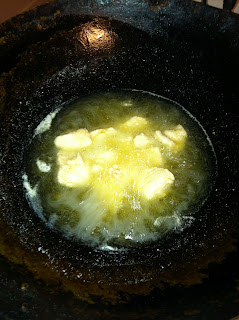 This is a delicious recipe for Japanese fried chicken with a spicy leek and red pepper sauce.
This is a delicious recipe for Japanese fried chicken with a spicy leek and red pepper sauce.The chicken is marinated in a combination of soy sauce, sake and sugar then battered in mochiko (Japanese rice powder), flour and salt. Its deep fried and served with nanban sauce (a spicy dipping sauce of ginger, leeks and red peppers).
Nanban sauce is a Chinese based Japanese dipping sauce. Nanban (南蛮)means southern barbarians, the character nan (南) meaning south (and referencing the Chinese communities in Nagasaki during the Tokugawa Shogunate) and ban (蛮) meaning barbarian (as in yabanjin 野蛮人). The leeks, ginger, garlic and raiyu make it very Chinese!
When I was working in Japan, this was one of my favorite dishes. Japanese fried chicken is delicious and very different from American/Pan Fried Southern Chicken. I would always get this when I would go to an Izakaya (Japanese style pub) or have an Enkai (company drinking party), so much so I became known as "the gaijin guy who likes chicken".
I adopted this recipe from Just Hungry, a blog about a Japanese lady living and working abroad.
Ingredients
Chicken thigh or breast, 1 lbs
2 tablespoons Nanban sauce (Chinese spicy leek sauce)
2 tablespoons Sake (Japanese Rice wine), preferably junmai
Mochiko flour, 1/2 cup
Cornstarch, 1 tablespoon
Salt, 1/2 teaspoon
Corn oil for frying
Directions
Cut chicken into bite sized pieces. I cut mine pretty small. In retrospect, it might have been easier to make the pieces a little bit bigger.
Strain some of the nanban sauce to remove the leeks, ginger and any vegetables. I usually strain it with a handheld strainer. You won't need too much, just about 2 tablespoons of the sauce.
Marinate the chicken in the Nanban sauce and sake for at least an hour, preferably overnight, in the refrigerator.
Remove the chicken from the refrigerator. As the chicken starts to come to room temperature, heat corn oil in a wok. Using a thermometer, bring the oil to around 340-360 F. Monitor this closely, as you don't want the oil to get hotter than this, it will ruin the flavor of the chicken.
 Make a batter by combining the Mochiko flour, cornstarch and salt. Place in a plastic rectangular box with a lid. With a pair of chopsticks remove a piece of the chicken. Shake off any excess soy sauce and pop it into the rectangular box with the mochiko flour. Continue to add pieces of chicken from the marinade to the mochiko flour box. When you have about 10 pieces, close the lid and give it a good shake to make sure all the chicken is coated.
Make a batter by combining the Mochiko flour, cornstarch and salt. Place in a plastic rectangular box with a lid. With a pair of chopsticks remove a piece of the chicken. Shake off any excess soy sauce and pop it into the rectangular box with the mochiko flour. Continue to add pieces of chicken from the marinade to the mochiko flour box. When you have about 10 pieces, close the lid and give it a good shake to make sure all the chicken is coated.Check the temperature of the oil, the addition of the chicken might have lowered the temperature of the oil. Adjust accordingly to reach the target temperature of 340-360 F for the oil.

With the same pair of chopsticks, pick up a piece of the chicken and shake off any extra mochiko powder. Gently place it inside the wok with the oil. I usually will put only a few pieces in at a time (maximum of around 5 pieces), you don't want to crowd the chicken. When they turn golden brown, remove with a slotted brass spoon and place on a paper towel to absorb any excess oil.
With a meat thermometer, test the internal temperature of the chicken. A cooked piece should have an internal temperature of around 192F-197 F. If it is around 165 F, it will probably be a little pink and uncooked in the center. You can also cut into one of the pieces to check if the meat is cooked. It should be white all around, with no pink whatsoever.
The finished chicken should look something like this: There should be some texture on the meat that the mochiko provides. Serve with rice and the nanban sauce.
.JPG)

No comments:
Post a Comment